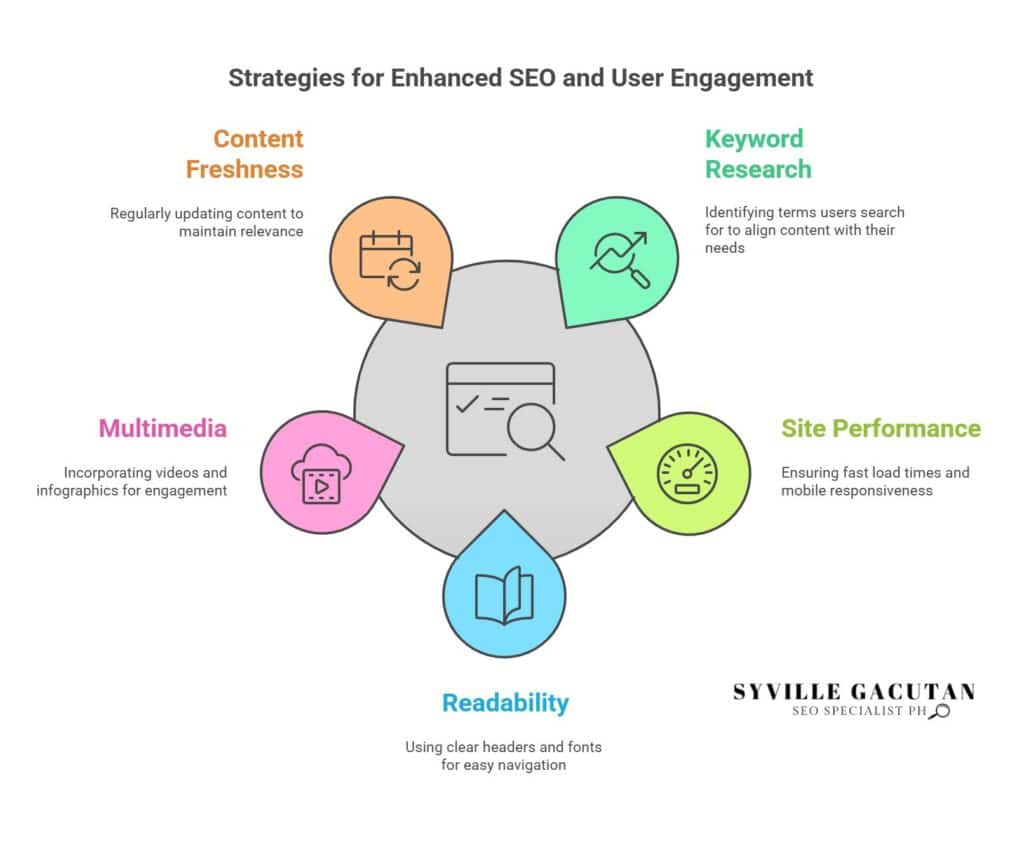
What Are Basic SEO Content Creation Strategies?
Creating effective SEO content for your website involves a few key strategies to boost visibility and improve your rankings. Start with a thorough site audit to spot any technical issues or content gaps that need fixing. From there, dive into keyword research to align your content with what your audience is searching for, focusing on long-tail keywords that offer more targeted opportunities. Build essential pages—your minimum viable product (MVP)—that are well-optimized, mobile-friendly, and focused on meeting your audience’s needs. Competitive analysis and paying attention to user experience (UX) can guide your approach, ensuring your content is both engaging and satisfying to visitors. To keep people interested, structure your content in a way that’s easy to read and break it up with visuals like infographics and videos. These simple strategies can go a long way in improving interaction and driving better results. If you’re ready to dive deeper into these SEO content creation strategies for beginners, there’s more to explore!
Key Takeaways
- Align content with search intent:Thorough keyword research ensures your content aligns with user search intent, boosting its relevance and search engine visibility.
- Optimize site performance: Focus on fast load times and mobile responsiveness to provide a smooth and enjoyable user experience, reducing bounce rates.
- Structure for readability: Use clear headers and easy-to-read fonts, making it simple for visitors to navigate your content and absorb information quickly.
- Incorporate multimedia: Add elements like infographics and videos to make your content more engaging, boosting time spent on your site and keeping users interested.
- Keep content fresh: Regularly review and update your content to maintain SEO friendliness and ensure it stays relevant to your audience’s needs.

Perform a Site Audit on SEO
Running a thorough site audit for SEO is an important first step to boost your online presence. It means carefully reviewing different parts of your website to see what’s working well and where improvements can be made to help your site show up better in search engine results. This process lets you pinpoint technical issues, content gaps, and other factors that might be holding your site back from reaching its full potential. By addressing these areas, you can set the stage for stronger search engine rankings and a better overall experience for your visitors.
A thorough site audit begins with assessing site performance by analyzing load times, mobile responsiveness, and the overall user experience. Ensuring that your site functions smoothly is paramount, as slow or unresponsive websites can deter user engagement and negatively impact search rankings.
The next aspect to consider is content inventory, which involves cataloging all existing content to evaluate its relevance, quality, and SEO friendliness. This step helps identify outdated or underperforming content, providing opportunities for updates or repurposing to better meet current SEO standards and audience needs.
Additionally, a technical SEO review is crucial for identifying and rectifying issues such as broken links, duplicate content, and errors in the website’s code structure. These technical aspects can significantly influence how search engines crawl and index your site, ultimately affecting your visibility.
Backlink analysis is another vital component of a site audit. It involves evaluating the quality and quantity of inbound links to your website, as backlinks are a significant factor in search engine algorithms. High-quality backlinks from reputable sources can enhance your site’s authority and search ranking.
Lastly, assessing user engagement metrics, such as bounce rates and session durations, provides insights into how users interact with your site. This information is invaluable for identifying areas of improvement and ensuring that your website effectively meets the needs of its visitors.
Start Keyword Research

Having laid the groundwork with a comprehensive site audit, the next logical step in optimizing your online presence is to start keyword research. This pivotal phase involves identifying the terms and phrases your target audience uses when searching for information related to your industry. Employing keyword tools can greatly assist in this process by providing insights into search volume, keyword difficulty, and potential content gaps.
Understanding search intent is crucial in selecting the right keywords. Search intent refers to the reason behind a user’s query. By aligning your content with the searcher’s intent, you can improve the relevance of your website pages and thereby enhance user engagement. Long tail keywords, which are typically more specific and less competitive, can further refine your strategy. These keywords often capture a more targeted audience and can lead to higher conversion rates.
| Keyword Tools | Search Intent | Long Tail Keywords |
| Google Keyword Planner | Informational, Navigational | “best Italian restaurant in NYC” |
| SEMrush | Transactional, Commercial | “affordable running shoes” |
| Ahrefs | Local, Branded Intent | “how to train for a marathon” |
Furthermore, analyzing keyword difficulty allows you to prioritize efforts on keywords that offer a balance between competition and opportunity. Using these insights, you can identify content gaps—areas where your competitors are ranking but you are not. Addressing these gaps by creating content tailored to your audience’s needs can significantly boost your site’s visibility and authority.
Embarking on keyword research with these strategies ensures your content is optimized to meet and exceed user expectations, ultimately driving organic traffic and achieving your SEO goals.
Establish MVP Pages
A website’s success hinges on its ability to deliver value through its most vital pages, often referred to as Minimum Viable Product (MVP) pages. These pages are integral components of an effective SEO strategy, designed to capture the essence of your site’s purpose while meeting the needs of your audience. By focusing on audience targeting, MVP pages ensure that content aligns with user interests and search intent, ultimately enhancing engagement and conversions.
To establish effective MVP pages, a strategic approach to page optimization is essential. Utilizing advanced SEO tools can facilitate this process by providing insights into keyword performance, competitive analysis, and user behavior. These tools assist in identifying high-impact keywords and phrases that should be integrated into MVP pages, ensuring they rank well in search engine results.
Additionally, these pages should be optimized for mobile responsiveness and fast loading times, as these factors are crucial to user experience and search engine rankings.
Content repurposing plays a vital role in maximizing the value of MVP pages. By adapting existing content into various formats—such as infographics, videos, or blog posts—businesses can expand their reach and reinforce key messages across different channels. This approach not only increases visibility but also enhances content promotion efforts by offering diverse ways for audiences to engage with your material.
Ultimately, establishing MVP pages is about creating a strong foundation that supports ongoing SEO initiatives. Through meticulous audience targeting, strategic page optimization, and effective content repurposing, businesses can ensure that their most essential pages continuously deliver value and drive success.
Perform a Competitive Analysis

Mastering SEO requires a thorough understanding of your competitors’ strategies, making competitive analysis a pivotal component of effective SEO content creation. By examining competitor strengths, businesses can identify what makes their rivals successful in search engine rankings. This involves scrutinizing their content strategies, keyword usage, and how they structure their pages to engage audiences. Understanding these elements can offer valuable insights into what is working well in your industry and how you can refine your approach.
A critical aspect of competitive analysis is identifying content gaps. These are areas where your competitors may be lacking, presenting opportunities for you to create unique content that addresses unmet needs within the market. By filling these content gaps, you can attract attention from audiences who are actively seeking the information that your competitors might not provide.
Analyzing backlink profiles is another essential element. By reviewing the backlinks that direct traffic to your competitors’ websites, you can understand their market positioning and identify potential link-building opportunities for your own site. Strong backlinks often indicate trusted and authoritative content, which is crucial for improving your own site’s credibility and ranking.
Understanding audience engagement through competitor analysis can also be invaluable. Examine how your competitors engage with their audience through various content forms, such as blogs, videos, and social media. By doing so, you can glean insights into what types of content resonate best with the target audience and tailor your strategy accordingly.
Incorporating this comprehensive approach to competitive analysis will enable a more effective SEO strategy, positioning your content to better compete in the digital marketplace.
Think About UX

In the realm of SEO content creation, prioritizing user experience (UX) is essential for maintaining audience engagement and achieving higher search engine rankings. Understanding user intent is crucial, as it guides the creation of content that resonates with the audience’s needs and interests. By aligning content with user intent, creators can enhance content engagement, ensuring that visitors find the information they seek and remain on the page longer.
Incorporating mobile optimization is another critical element of UX. With an increasing number of users accessing content via mobile devices, ensuring that websites are mobile-friendly is imperative. Mobile optimization not only improves user experience but also boosts search engine rankings, as search engines prioritize mobile-friendly sites.
To achieve this, consider the following:
- Responsive Design: Ensure website layouts adapt seamlessly across various devices and screen sizes.
- Fast Loading Times: Optimize images and scripts to reduce load times, which directly impacts user satisfaction and engagement.
- Touch-Friendly Navigation: Design intuitive interfaces that are easy to use on touchscreens.
User feedback is invaluable for continuous improvement in UX. By actively seeking and analyzing feedback, content creators can identify areas for enhancement, fostering a more satisfying user experience. This iterative process demonstrates a commitment to meeting user expectations and refining content over time.
Lastly, adhering to accessibility standards is vital for inclusive content. By ensuring content is accessible to users with disabilities, you broaden your audience and comply with legal requirements, fostering a more equitable online environment.
Prioritizing UX by focusing on user intent, mobile optimization, user feedback, and accessibility standards can significantly enhance content effectiveness and search engine visibility.
Structuring Content for Readability

Crafting content with readability in mind is a fundamental component of effective SEO strategy. Ensuring that your content is easily digestible not only enhances user experience but also improves search engine ranking.
A well-structured content hierarchy is pivotal; it guides readers through the information logically, facilitating comprehension and retention. This hierarchy is often established through the strategic use of header tags, which break down content into scannable sections and signal importance to search engines.
Font readability is another critical aspect. Selecting a clear and legible font helps maintain reader engagement by reducing eye strain, which is particularly important for digital platforms. Pairing this with optimal font size and line spacing can significantly enhance readability.
Bullet points are a valuable tool for summarizing key information succinctly, enabling readers to quickly grasp essential details without wading through dense paragraphs. They are especially effective in lists and comparisons, where clarity and brevity are paramount.
Whitespace usage is equally significant in structuring content for readability. Adequate spacing between paragraphs and sections allows the eye to rest, preventing the page from appearing cluttered.
This not only contributes to a clean and professional aesthetic but also aids in maintaining reader focus and reducing cognitive overload.
Incorporating Visual Elements

Having established a strong foundation for readability, enhancing content with visual elements becomes the next strategic step in effective SEO content creation. Visual storytelling not only enriches user experience but also improves engagement metrics, which are crucial for search engine rankings. Incorporating visual elements demands a keen eye for graphic balance and a thorough understanding of multimedia integration.
- Infographic Design: Infographics are powerful tools in visual storytelling, providing a concise and engaging way to convey complex information. They can increase dwell time on pages, a metric valued by search engines. Ensure your infographic design is not just visually appealing but also aligned with the content’s message and SEO goals.
- Video Optimization: Videos are increasingly becoming a staple in content strategies. When incorporating videos, focus on video optimization techniques such as adding relevant keywords in titles, descriptions, and tags. Additionally, transcripts can enhance accessibility and provide additional SEO benefits.
Videos should load quickly and be appropriately sized to maintain graphic balance without compromising page speed.
- Multimedia Integration: Combining images, videos, and graphics within text creates a cohesive narrative, enhancing reader comprehension and retention. However, it is vital to maintain a seamless multimedia integration to prevent visual clutter, which could detract from user experience.
Each element should complement the content, guiding the reader’s journey through your page.
Final Thoughts
Implementing basic SEO content creation strategies is essential for building a strong online presence and improving your site’s visibility. By focusing on foundational elements such as site audits, keyword research, competitive analysis, and user experience, you can ensure your content not only ranks well but also resonates with your audience. Incorporating readability techniques and visual elements like infographics and videos further enhances engagement and SEO performance. Staying consistent with these strategies will help your website evolve with user needs and search engine algorithms, driving long-term success.
Need expert help optimizing your website’s content for better SEO performance? Connect with Syville Gacutan, an experienced SEO Specialist in the Philippines. Syville can guide you in creating SEO-friendly content that drives traffic, engages users, and boosts search rankings. Contact today to get started!